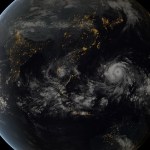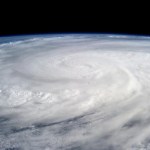Typhoon Haiyan, which made landfall in the Philippines on Nov. 7, is another sobering reminder of the severe weather we are provoking through climate change. It is unofficially the strongest recorded cyclone to ever make landfall, with wind speeds up to 195 mph, 70% stronger than Hurricane Sandy. Villages are flattened, and more than 5,000 people are confirmed dead (as of 11/22). Greg Laden says that tropical cyclones feed on heat energy from the sea’s surface, from seas we know are getting warmer. Haiyan was a storm that blew past the most dire classification, Category 5, which tops out at a…
typhoons
At this moment, there is a guest post over at WUWT blog downplaying the size, strength, wind speeds, overall effects, and even the death toll of Super Typhoon Haiyan. Even as the monster storm steams across the sea to it's next landfall (probably as a huge wet tropical storm, in northern Vietnam and southern China), Anthony Watts and his crew are trying to pretend this monster storm didn't happen, and instead, that it was a run of the mill typhoon.
At the moment, nobody is really saying that Haiyan's strength, size, power, or even existence is specifically the direct result of global warming…
Mark Pendergrast writes: To kick off this book club discussion of Inside the Outbreaks, I thought I would explain briefly how I came to write the book and then suggest some possible topics for discussion.
The origin of the book goes back to an email I got in 2004 from my old high school and college friend, Andy Vernon, who wrote that I should consider writing the history of the EIS. I emailed back to say that I was honored, but what was the EIS? I had never heard of it. I knew Andy worked on tuberculosis at the CDC, but I didn't know that he had been a state-based EIS officer from 1978…

